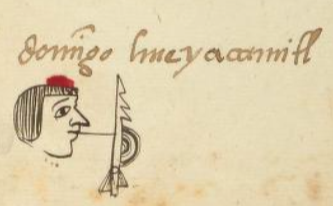Hueyacamitl (MH900v)
This black-line drawing of the simplex glyph for the personal name Hueyacamitl (“Large Cane Arrow”) is attested here as a man’s name. The glyph shows a vertical arrow, point up, with three barbs on the tip and fletching at the lower end. At about the middle, off the right side, is half a pool of water (atl), with alternating thick and thin lines of current (concentric half-circles) that suggest it is a whirlpool (with movement). The purpose of the atl seems to be to provide a phonetic complement to the “a” of acatl.
Stephanie Wood
Since the water almost seems to be a part of the weapon, two swirling water glyphs appear below to support the reading of atl. The intentionality of the large (huey) size of this arrow also becomes evident when seeing a more typical acamitl (below).
Stephanie Wood
domīgo hueyacamitl
Domingo Hueyacamitl
Stephanie Wood
1560
Jeff Haskett-Wood
flechas, armas, agua, cañas, tamaño, nombres de hombres

huey, large, https://nahuatl.wired-humanities.org/content/huey
aca(tl), reed or cane, https://nahuatl.wired-humanities.org/content/acatl
mi(tl), arrow, https://nahuatl.wired-humanities.org/content/mitl
a(tl), water, https://nahuatl.wired-humanities.org/content/atl
Flecha Grande de Caña
Stephanie Wood
Matrícula de Huexotzinco, folio 900v, World Digital Library, https://www.loc.gov/resource/gdcwdl.wdl_15282/?sp=873&st=image.
This manuscript is hosted by the Library of Congress and the World Digital Library; used here with the Creative Commons, “Attribution-NonCommercial-ShareAlike 3.0 License” (CC-BY-NC-SAq 3.0).



